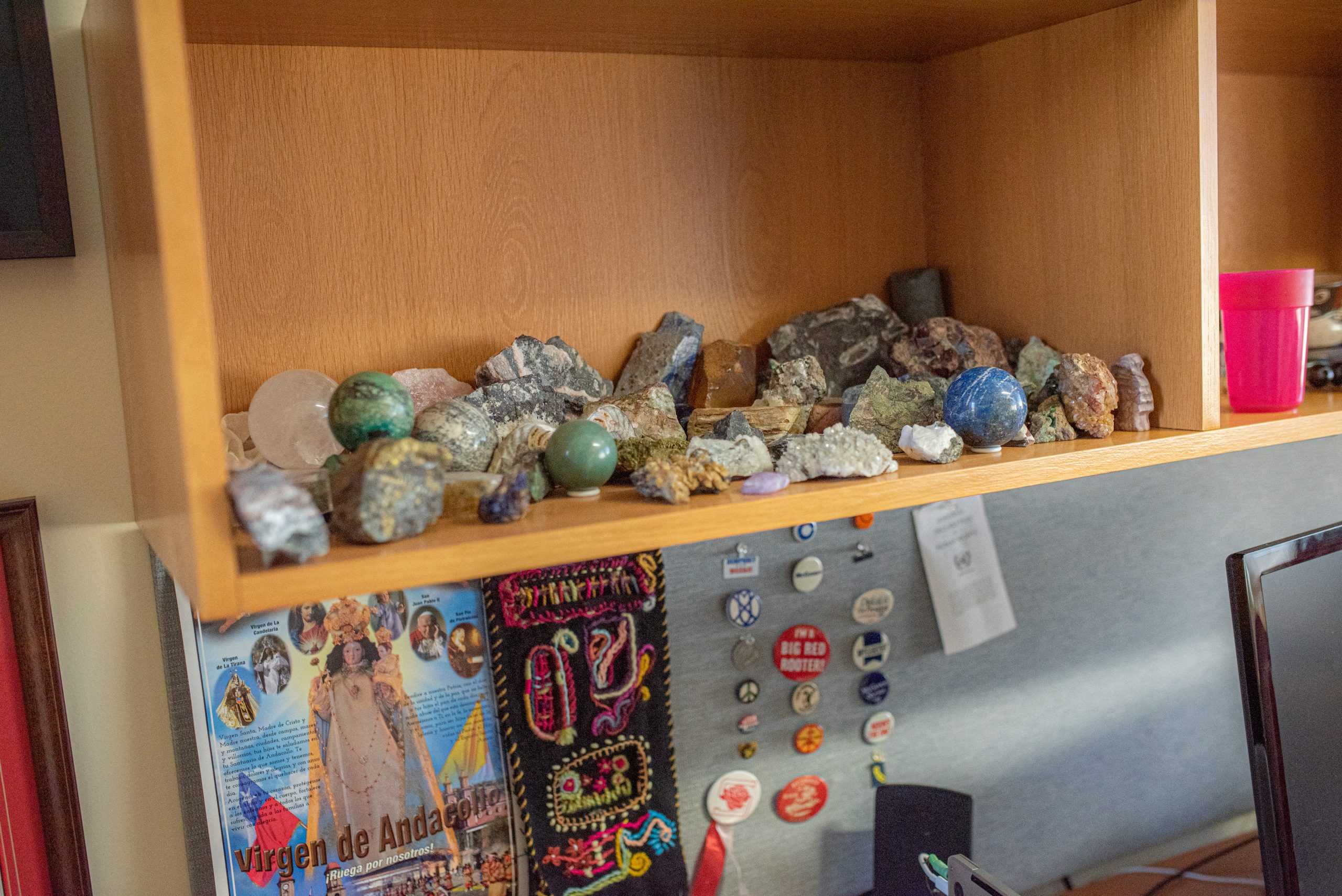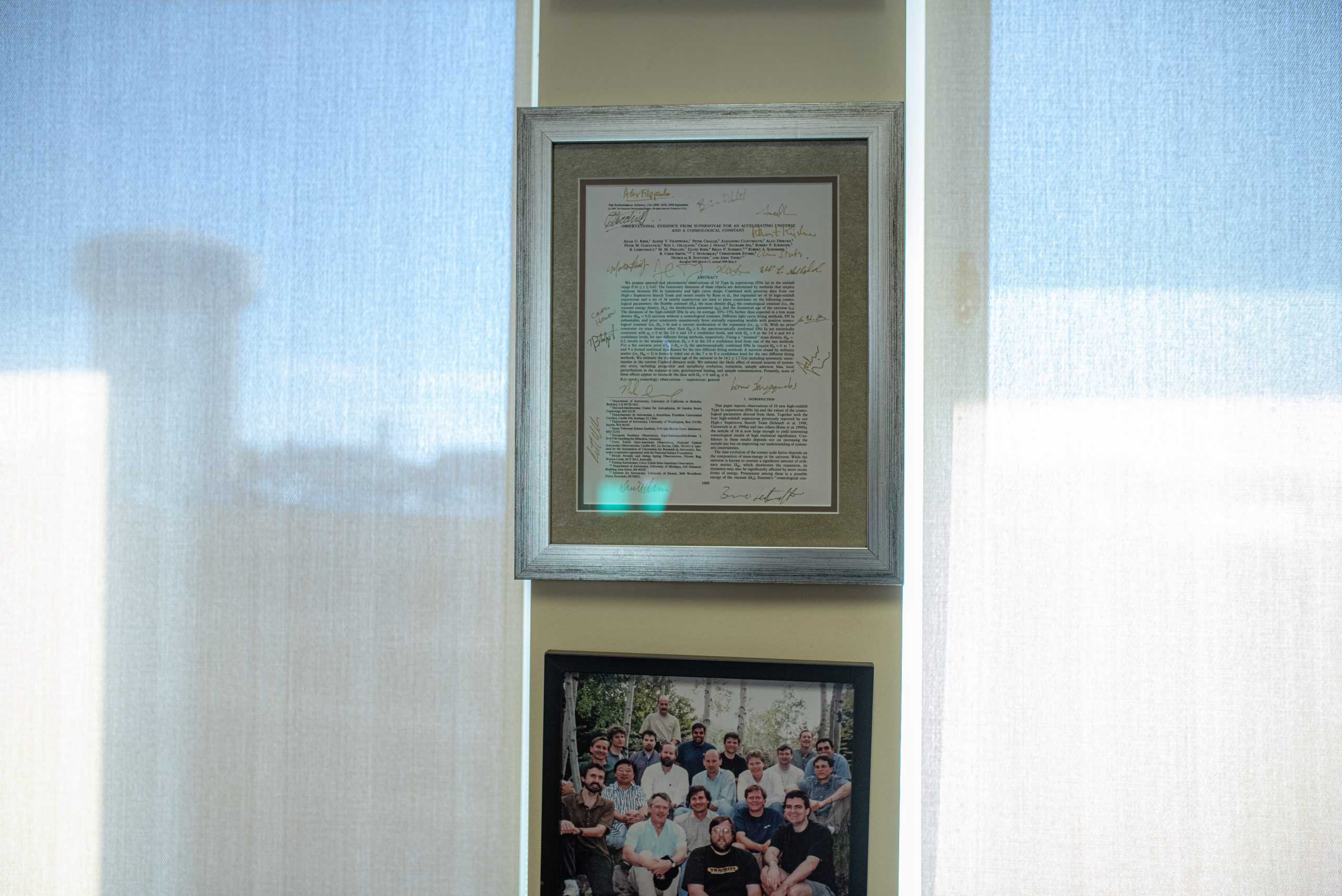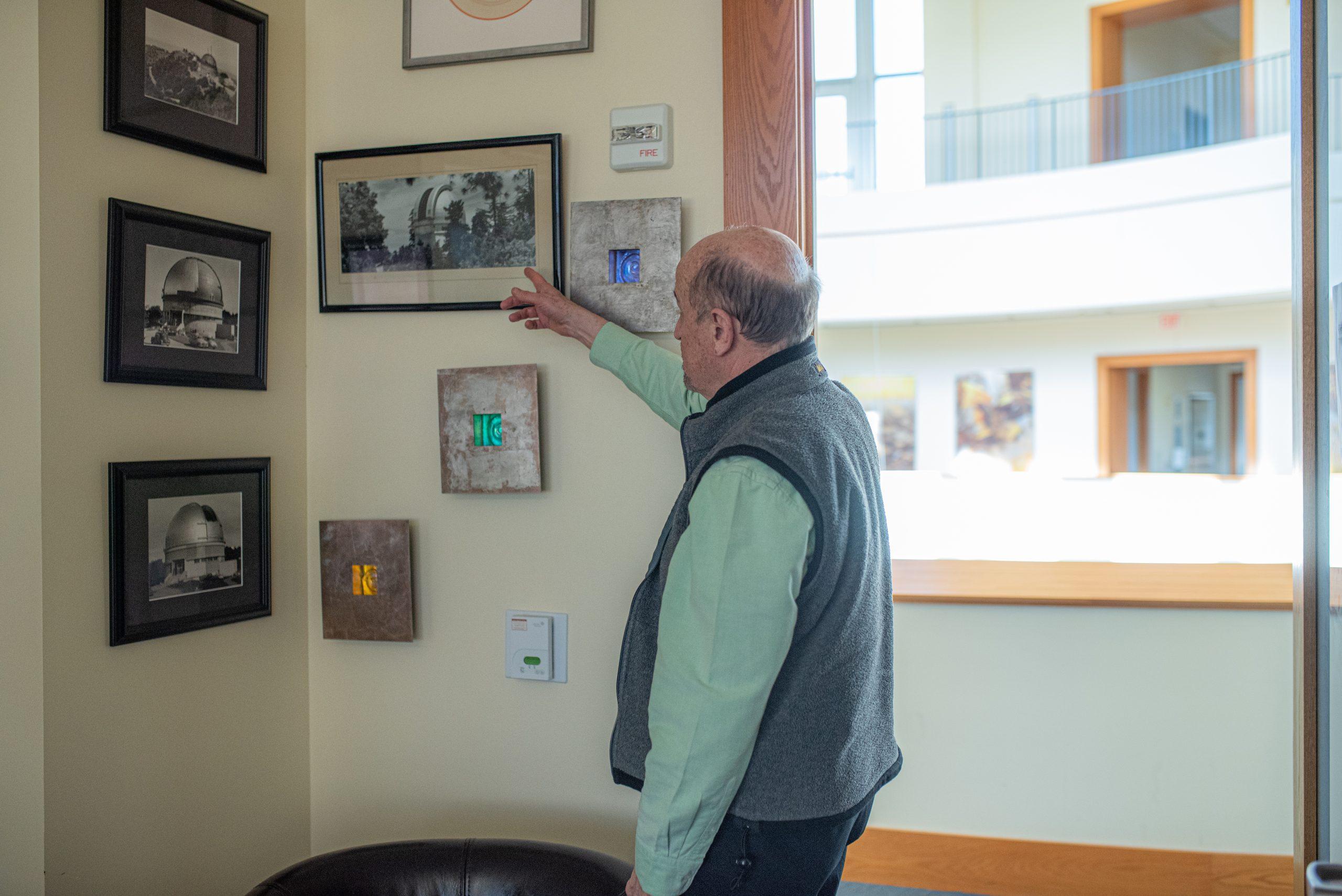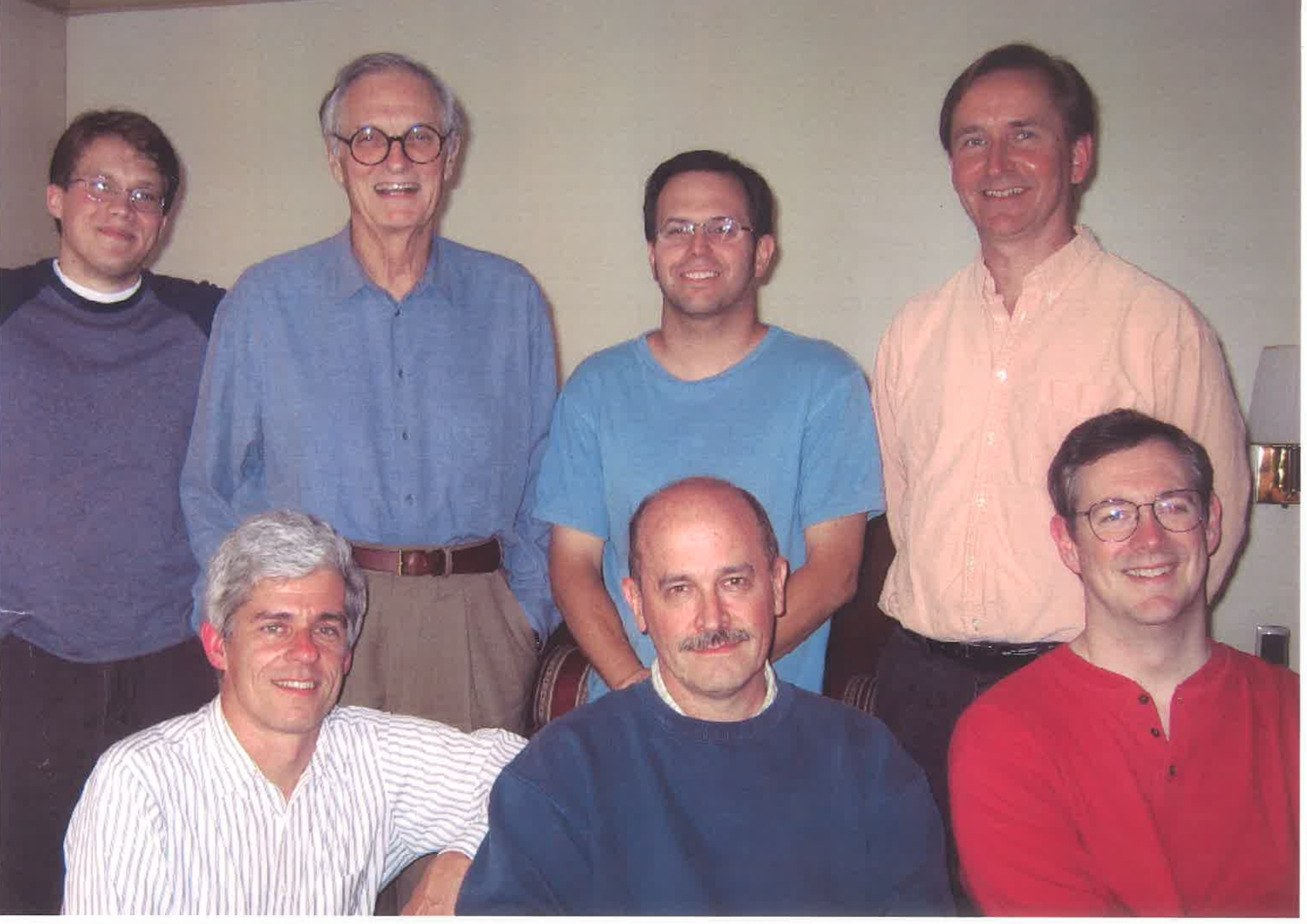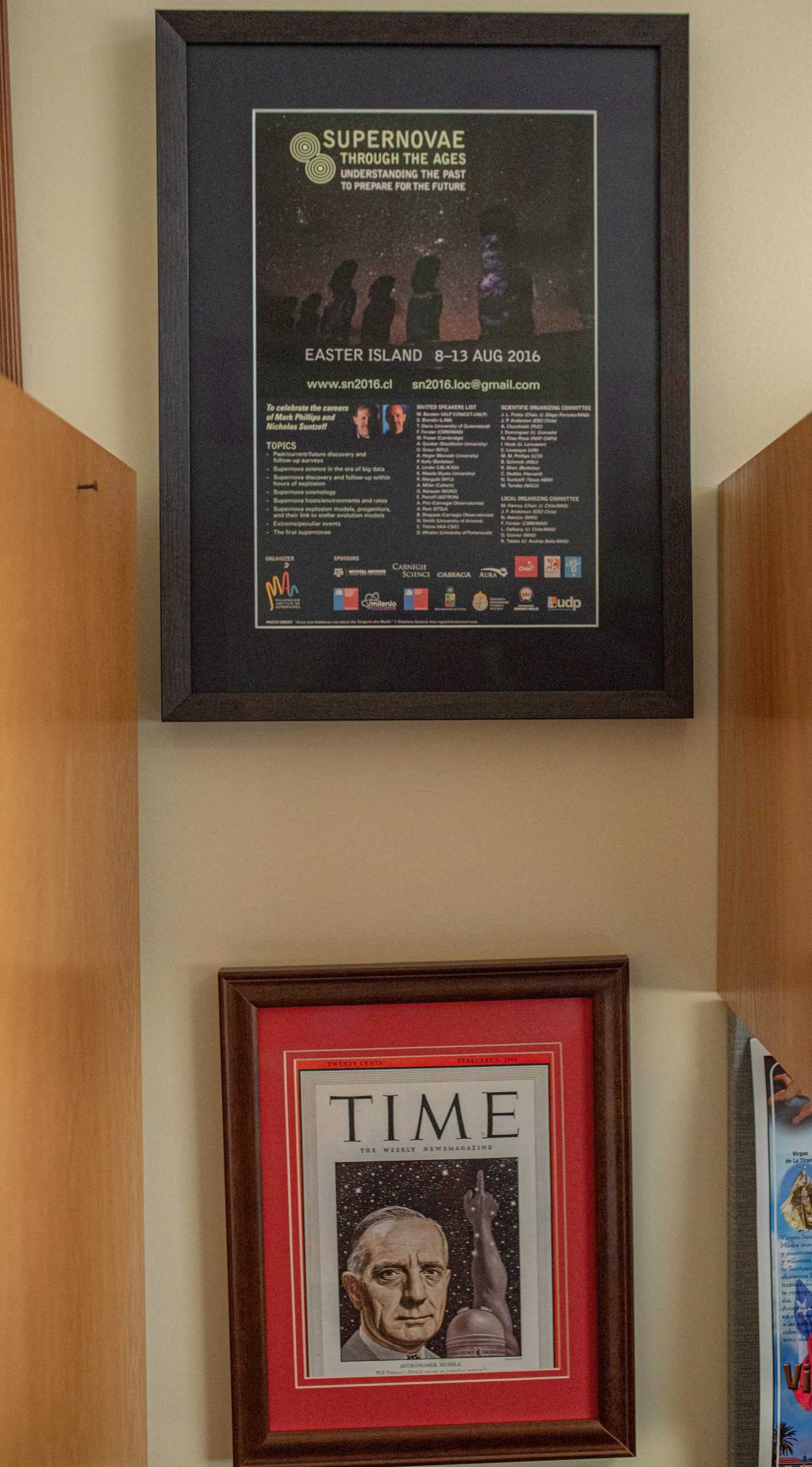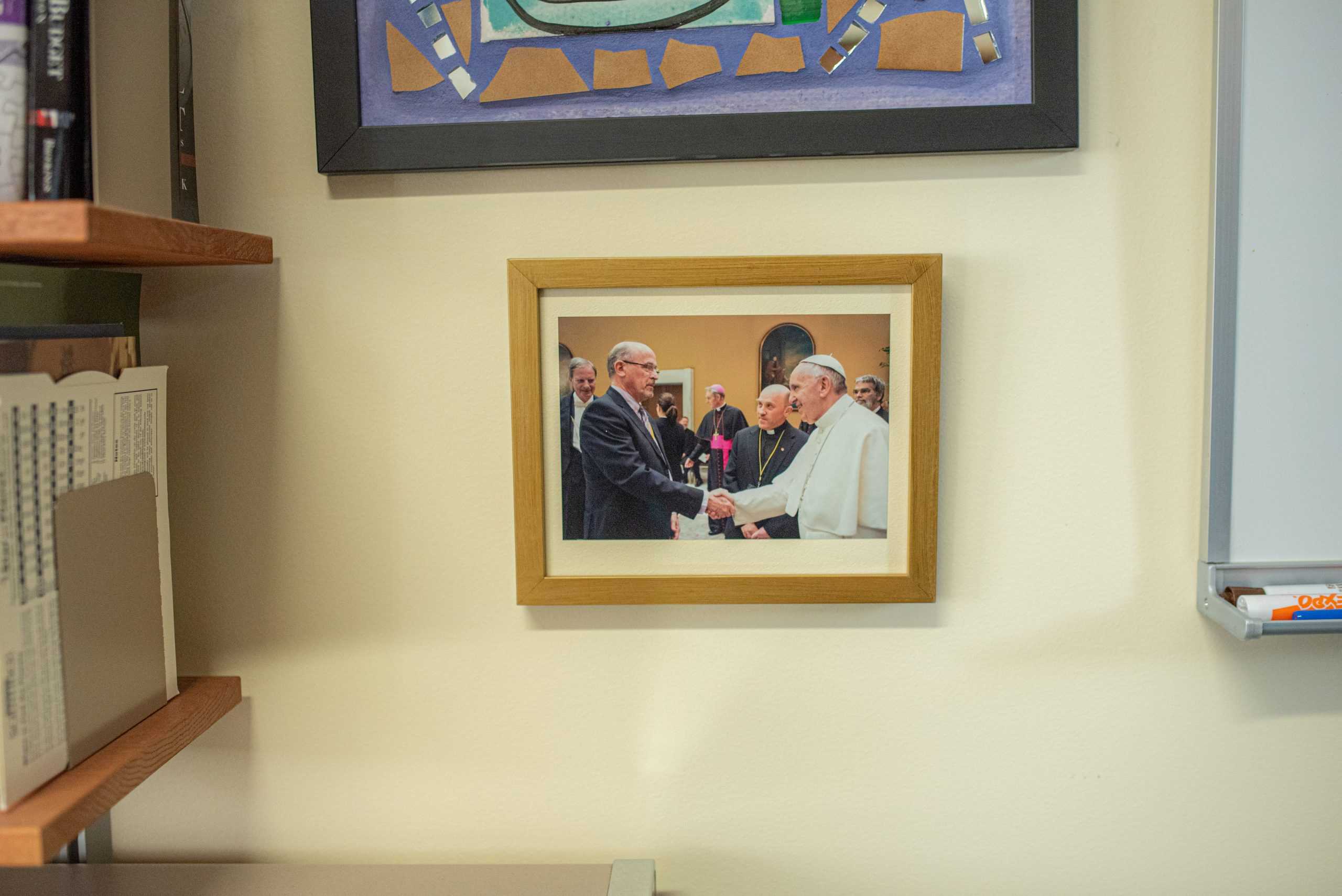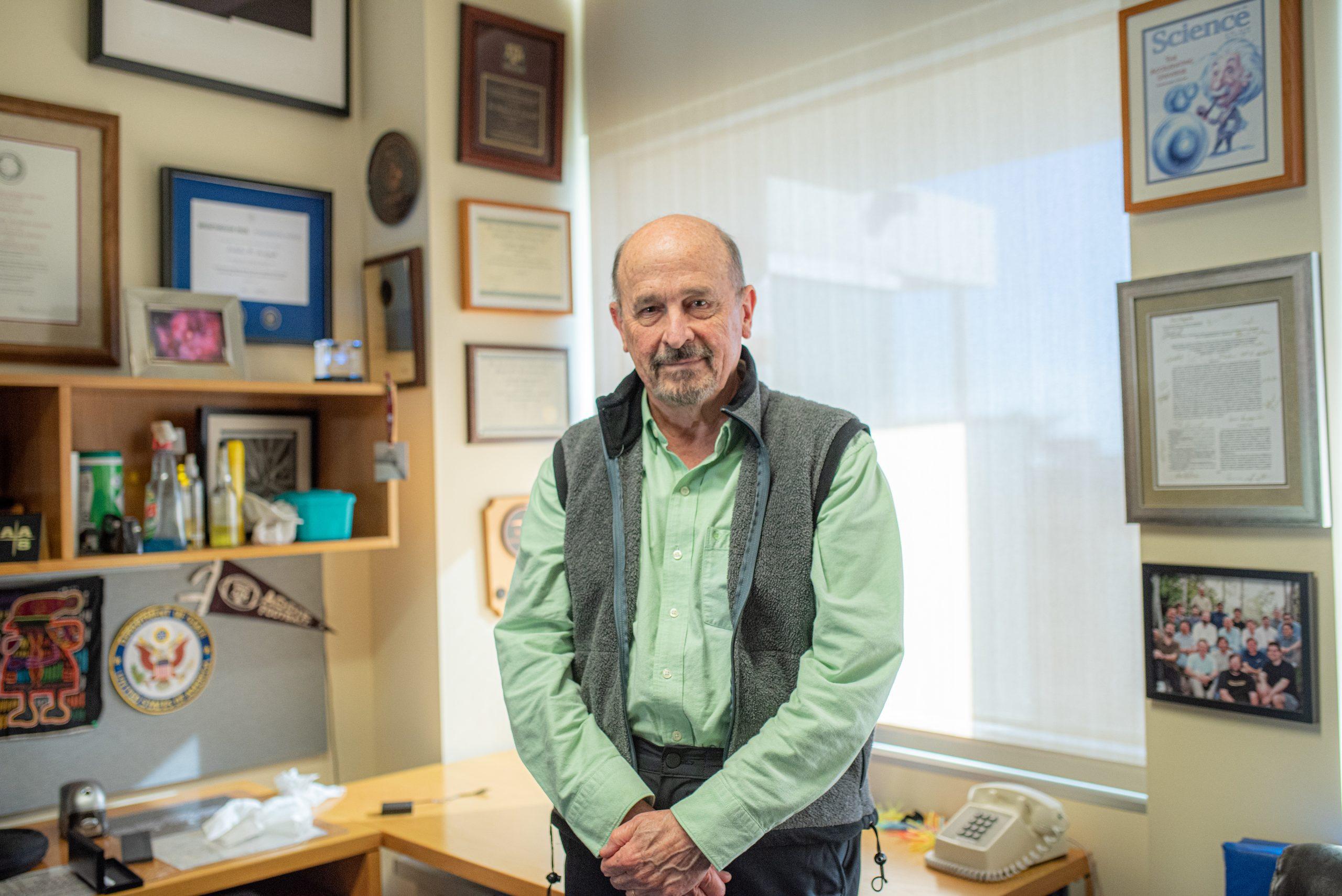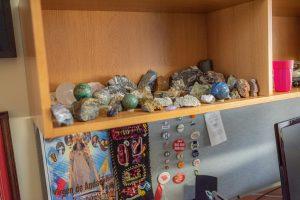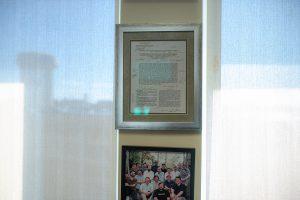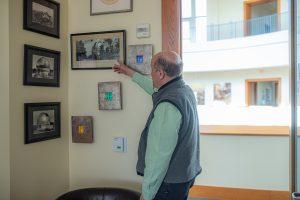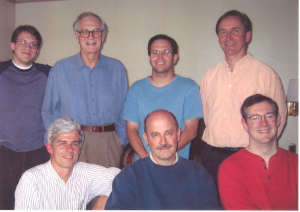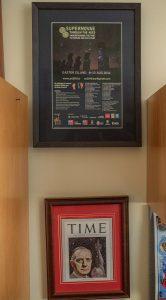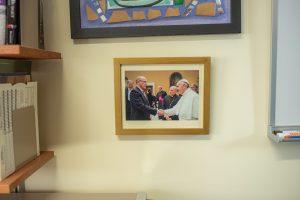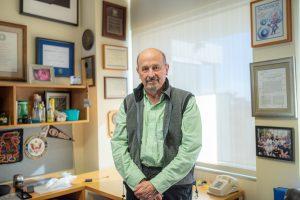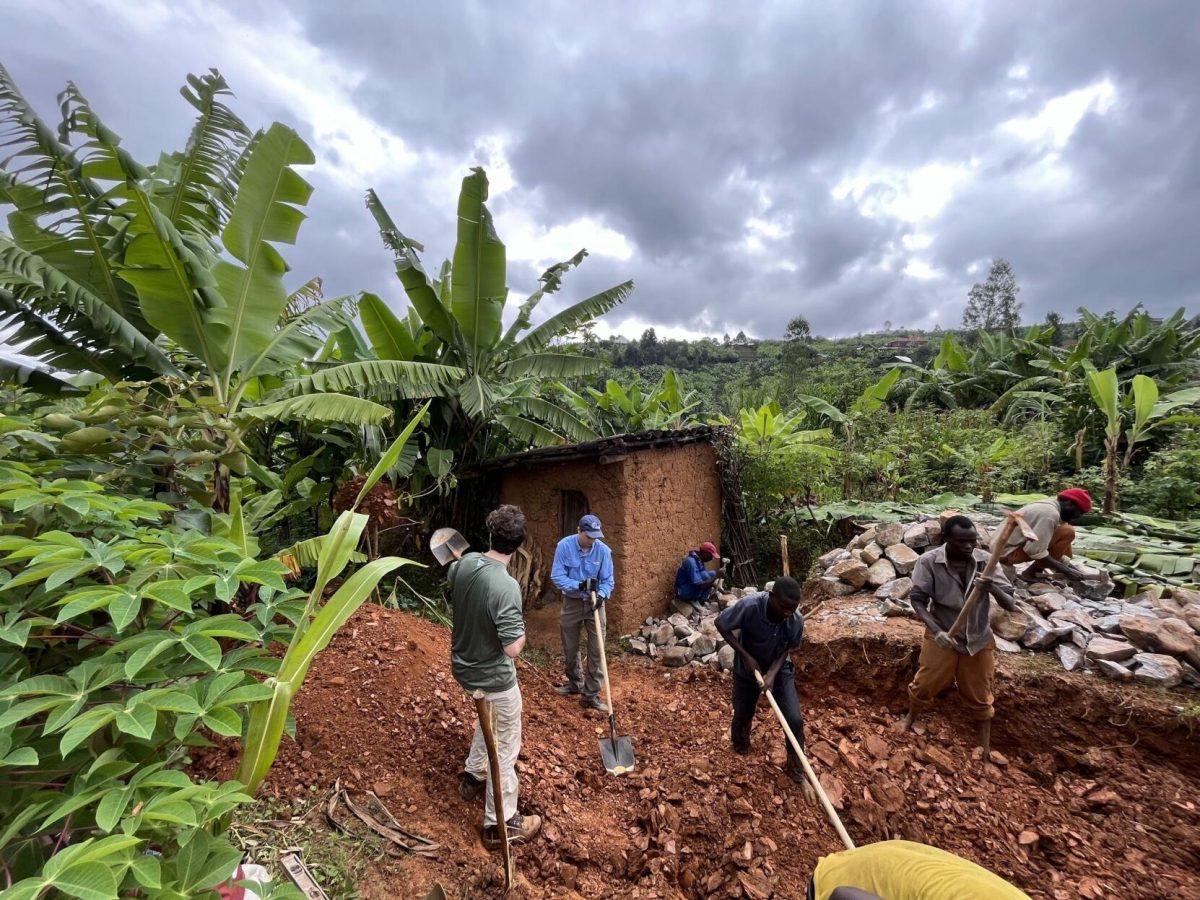Editor’s Note: This article has been updated since initial publication to correct factual errors.
After 17 years at Texas A&M, Nick Suntzeff, Ph.D., director of A&M’s astronomy program, is set to retire at the end of this semester. Students who have met him likely did so through his introductory astronomy class, ASTR 101, one of the most popular elective courses A&M offers. Outside Aggieland, however, he is more well known for helping discover 70% of the universe.
Born in the San Francisco Bay Area in 1952, Suntzeff attended Stanford University, graduating with a bachelor’s degree in physics and mathematics in 1974, and received a doctorate in astronomy from the University of California, Santa Cruz, in 1980. During his time at Stanford, Suntzeff led a group of students that included astronaut Sally Ride to build the Stanford Student Observatory, which continues to be used by Stanford students today.
“Mike Kast and I built this observatory at Stanford back when we were undergrads,” Suntzeff told TAMU Science in 2014. “Amazingly, it is still there and has not burned down, considering I did much of the wiring … It is still there and still being used for a popular astronomy lab class. Sally Ride helped and was a student in the first lab class we had[.] The real catalyst was Dr. Walter Meyerhof, who was the chairman of the Physics Department back then and had confidence that a bunch of green undergrads could do such a project.”
After receiving his doctorate, Suntzeff worked as a fellow at Carnegie Observatories in Pasadena, California under astronomer Allan Sandage. Suntzeff said Sandage convinced him to enter cosmology, the study of the universe’s origin and history.
“When I got to [Carnegie Observatories], there was an astronomer there, Allan Sandage, who had been [Edwin] Hubble’s student,” Suntzeff said. “Sandage kept on pushing me, saying, ‘Admit you like cosmology, you want to do it, and go after the big questions. Don’t stop doing the stuff you’re doing, but realize that there are bigger questions to answer.’”
At the time, the Big Bang had already been generally accepted as a plausible explanation for the universe’s origin after the discovery of cosmic background radiation. Suntzeff said Sandage believed two physical values were needed to figure out exactly how long ago the event was, the central question of cosmology.
“[He] told me that in the grand scheme of things in astronomy, there really are only two numbers you have to measure to answer the biggest question,” Suntzeff said. “That question is, ‘How old is the universe and how did it come into being? Those two numbers are called [the Hubble constant], how fast the universe is expanding today, and the other one is called the deceleration parameter. The deceleration parameter says, ‘OK, the universe is expanding this fast today, how much slower is it going to be expanding in the future?’”
At the time, Suntzeff said scientists generally agreed the expansion of the universe was slowing down in accordance with the general behavior of objects affected by gravity.
“No one thought [the expansion of] the universe was speeding up over time,” Suntzeff said. “Everything in gravity slows down, you throw something up in the air and it slows down, stops and comes back and hits you in the head.”
Upon the conclusion of his fellowship, Suntzeff moved south to the Cerro Tololo Inter-American Observatory in Chile, continuing to work on Sandage’s projects. At Cerro Tololo, Suntzeff said he was introduced to an intriguing idea of how to measure long distances in the universe.
“Sandage was down there [in Chile] working on his project with another astronomer, Gustav Tammann,” Suntzeff said. “They were after measuring the deceleration of the universe and he had the idea that supernovae could be used to measure distances in the universe.”
The search for supernovae at Cerro Tololo, however, was not going well, Suntzeff said. Deficiencies in the contemporary scientific hardware made finding supernovae prohibitively difficult, to the point that Suntzeff said a fed-up Sandage gave reins of the project to him and his colleagues Mario Hamuy, Mark Phillips and Jose Maza.
“Sandage and Tamman quit … but he encouraged his students [to continue the project],” Suntzeff said. “So Mark and I and Jose and Mario took it over.”
The Chile team remained persistent. While most of the astronomical community focused on conventional supernovae, the explosions at the end of a massive star’s life, the team looked into type Ia supernova, supernovae that arise from white dwarves, the remnants of sun-like stars, that absorb mass from an orbiting companion star. Due to the set amount of mass that a white dwarf can attain before a supernova is triggered, unlike conventional supernovae, where stars reach varying masses before exploding, Suntzeff said type Ia supernovae would better serve as indicators for cosmic distances.
“When a [type Ia supernova occurs], it gets to a standard brightness, like a 100 Watt light bulb … you can figure out how far away the light bulb is by how faint it appears,” Suntzeff said. “It’s the same with these exploding stars. As a star explodes in a galaxy, and in any one galaxy every 100 years or so a star will explode like this, we can measure the distance to a galaxy.”
By 1994, with a combination of patience and technological innovations they developed, Suntzeff said the Chile team published studies proving type Ia supernovae could be used as cosmic measuring sticks. The methods pioneered by the team would eventually enable scientists to find an accurate value for the rate of the universe’s expansion.
“By 1994, we published the fundamental calibration and how to use exploding type Ia supernovae to measure distances,” Suntzeff said. “We prove that we could measure distance to better than 6% [error] … prior to our work, you couldn’t measure distances to distant galaxies with much better than 20-30% [error]. The final value, the Hubble constant, was published by [director of Carnegie Observatories] Wendy Freedman and collaborators in 2002. She used our [type Ia] supernovae.”
Still unknown, however, was Sandage’s second number, Suntzeff said.
“I started saying, we’ve done the calibration to measure the Hubble constant,” Suntzeff said. “Now, let’s do the question of measuring the deceleration of the universe.”
With Brian Schmidt, Ph.D., at the time an astronomer at Harvard University, Suntzeff formed the High-z Supernova Search Team, an international group of astronomers to find the value of deceleration. Schmidt said the two collaborated after forming a working relationship in Chile.
“I met Nick on a visit down to Cerro Tololo Observatory in Chile in 1991. I spent several months there, and so when I was there we got to know each other. I was working on my Ph.D. thesis … [Nick] was a very useful person for me because he taught me a lot,” Schmidt said. “When I finished my thesis, I knew I was moving down to Australia, but I had a pretty big observing run in Chile and we had started talking about a project to measure the deceleration of the universe.”
In order to corner this value, Suntzeff said the group intended to analyze the way light waves emitted by distant type Ia supernovae stretched out, or redshifted, as their origins traveled away from the Earth, revealing the speed at which the universe had expanded in the past.
“If there were enough supernovae, we had signposts backwards in the universe where we could measure how far away the stuff was,” Suntzeff said. “We can also measure how much the universe has stretched the redshift between there. Those concepts of distance, and how much it stretches by, allow you to measure the deceleration of the universe.”
The group, however, had competition. Peter Garnavich, Ph.D., at the time a Harvard researcher and a key member of the High-z team, said a team of physicists led by Saul Perlmutter, Ph.D., a physicist at Lawrence Berkeley National Lab, had already entered the race to find the unknown number.
“There was a bunch of physicists led by Saul Perlmutter that had been trying to [find the deceleration parameter] for a few years and not really making much progress,” Garnavich said. “We thought there was an opening to jump in and use our knowledge about supernovae to solve some of their problems.”
Though the two groups had the same goal, Schmidt said their philosophies were fundamentally different and made cooperation impossible.
“They were physicists, and they had certain ways of doing things which was, if I could be honest, to essentially invent everything from scratch and ignore 100 years of astronomy,” Schmidt said. “It was clearly not going to be that we could collaborate with them in the way we felt was appropriate.”
While the two teams worked independently for the most part, Alex Filippenko, Ph.D., at the time a researcher at the University of California, Berkeley, left Perlmutter’s team to join Suntzeff’s team. Filippenko said he was motivated by the more collegial atmosphere of Suntzeff’s team as well as his personal friendships with the astronomers.
“I was originally on the other team, called the Supernova Cosmology Project, led by Saul,” Filippenko said. My friends and colleagues who studied exploding stars, supernovae, were on the other team, a team formed by Nick and Brian. I eventually switched to that team. I wasn’t really getting along as well as I would like with Perlmutter’s team, and more of my buddies, my colleagues, were on the Suntzeff team.”
In Chile, Suntzeff’s activities were not limited to astronomy. Alan Alda, who starred in the TV show MASH, wrote in his 2006 memoir Never Have Your Dog Stuffed: And Other Things I’ve Learned that he met Suntzeff while he was in town filming a documentary, and that Suntzeff even helped save his life after he suffered a medical emergency.
“The [ambulance] motor turns over, again and again, without success. Someone gets out and tinkers under the hood. Finally, the motor rumbles and we start the hour and a half descent down bumpy mountain roads,” Alda wrote. “About halfway down, Nick Suntzeff, the astronomer, reassures me that we’re getting onto a stretch of smooth road now.”
After the episode, Garnavich said Suntzeff and Alda became close friends.
“Alan Alda came down with his crew to tape one of the science shows he was hosting. He was going up to the [Victor M. Blanco] Telescope and was watching us get data, but it turned out that he was actually very sick. He had a problem with his intestine and had to be rushed to the hospital,” Garnavich said. “Nick and Alan ended up becoming really great friends because Alan had to stay recuperating for several weeks in La Serena, Chile, where the headquarters for the observatory was.”
Suntzeff’s team of observational astronomers in Chile would record data and send them to their collaborators, such as Filippenko, Garnavich, Schmidt, now in Australia, and Adam Riess, who had been a Harvard graduate student but was then a Berkeley researcher, to process. To avoid experimental bias, the processors would refrain from sharing their results with the observers. Mysteriously, Suntzeff said, the astronomers processing his data began frequently asking to confirm measurements, as if they were apprehensive about something.
“We were feeding data to the Berkeley group and they would be asking us questions, like, ‘are you sure those numbers are right, can we check those numbers?’” Suntzeff said. “They were puzzled by what we were giving them, but they weren’t telling us what they found.”
In December of 1997, Schmidt, Filippenko, Riess, Garnavich and collaborators had enough data from Suntzeff’s team to confidently produce a value of the universe’s deceleration. To his surprise, Schmidt said, the universe’s expansion seemed to not be decelerating — it was, instead, accelerating.
“I just assumed we had made a mistake … So we started going through [the data] bit by bit by bit, and then, you know, it took a couple of months, going through every little bit, and [the result] didn’t really move at all,” Schmidt said. “It just kind of emerged. It wasn’t like this eureka moment.”
The team debated whether to move forward with publishing a result that appeared to be scientifically impossible, as a universe expanding at an accelerating rate suggested the unlikely presence of some sort of phantom force. Eventually, Suntzeff said, he decided that the finding would be published as the data was sound, regardless of the results it had produced.
“Some of us didn’t want to publish it because they thought it was just wrong. I wasn’t one of them,” Suntzeff said. “I said the data is good. There could be another explanation [that wasn’t the phantom force], but we’ve got to go publish the data … if we’re right, everybody is going to remember us. If we’re wrong, well, at least they’re going to use our data.”
Riess, who did the bulk of the work on the data processing and would be credited as first author in the later study, said while the unexpected result intimidated him, Suntzeff’s approval gave him confidence to move forward with it.
“I thought we did something wrong,” Riess said. “We got this number that was the complete opposite of what we thought it would be. We thought about what could’ve gone wrong, we looked at the data, the process, the chain of logic, the analysis, and by the end, having run through this gauntlet, you know, questions, considerations, concerns, challenges, we finally looked at it and said, ‘We got it right.’ And when Nick says you’re right, you really know you’re right.’”
Suntzeff said he initially thought the scientific community would react with strong skepticism. However, unbeknownst to him, Perlmutter’s group had simultaneously reached the same conclusion, making the High-z group’s finding unlikely to be a fluke.
“We both came out and said the same thing, which shocked us, but then I think shocked everyone else, that two teams that seemed to be working independently came up with the same answer,” Suntzeff said. “That was, that the universe was in acceleration.”
The accelerating universe model, Schmidt said, also received support from the theoretical physics community.
“I thought people were going to be more than skeptical,” Schmidt said. “I thought they were going to be scathing. But it did turn out that the theory community, led by the guys mainly out of the University of Chicago, [professor of physics at the University of Chicago] Mike Turner, some other people said, ‘Hey, this fixes everything. Cosmology makes sense if this is true.’”
The unknown force driving the acceleration of the universe’s expansion was dubbed by Turner as dark energy, which although miniscule, due to sheer volume, is thought to comprise roughly 70% of the universe’s mass-energy content. Suntzeff said its identity is as much of a mystery today as it was 26 years ago.
“It was terrifying to us when we discovered it,” Suntzeff said. “[Dark energy] was what we were seeing, and it was in the numbers that we were measuring, but we can’t explain why it’s there. There’s not even a clue of how to approach it, because the number’s so small we can only measure it over distances halfway across the universe … I don’t think we’re gonna know what it is for a long, long time.”
Suntzeff’s sentiments were echoed by Schmidt, who said it was difficult for him to imagine a path to finding experimental evidence for dark energy at the current time.
“You never know,” Schmidt said. “Something may pop out somewhere, somehow, that gives you a clue. But at this point, I just can’t see how we’re going to resolve it, except for some theoretical understanding of why it might be there.”
A more optimistic outlook was offered by Garnavich, who is now chair of the physics department at Notre Dame University. Garnavich said new technologies and ingenuity could create clues in the near future.
“The [James Webb Space Telescope] and the upcoming Roman Space Telescope will go a long way towards narrowing the nature of the dark energy,” Garnavich said. “Never underestimate the inventiveness of theoretical astrophysicists.”
Filippenko and Riess, now professors of astronomy at the University of California, Berkeley, and Johns Hopkins University, respectively, continue to work together trying to ascertain the nature of dark energy. Cosmology, Riess said, is still an active and unsettled field.
“Dark energy is an exciting discovery, and it is part of the cornerstone of what we understand about the universe as well as the things we don’t,” Riess said. “However, what we’ve found is, even with dark energy, the universe still seems to expand faster than we expect. This phenomenon is called the Hubble tension and we continue to work on finding what it is … the subject of cosmology is not finished.”
Filippenko said a recent study the two published suggests that dark energy may be some form of vacuum energy, universal underlying background energies that arise from complex quantum properties of matter.
“We just published a result last year where the current expansion rate tells us something about what this dark energy might be,” Filippenko said. “It’s consistent with being some sort of vacuum energy … it isn’t necessarily, but just might be an energy associated with the vacuum of space.”
Suntzeff continued working as an astronomer at Cerro Tololo until 2006, when then-A&M President Robert Gates, Suntzeff said, approached him with an offer to found A&M’s astronomy program.
“At that time, our budget was declining rapidly, and I was just fed up with our declining budget, so I was intrigued by this offer. I wasn’t intrigued by living in Texas,” Suntzeff said. “But when I came here, it was much more fascinating than I expected. The people I met, I was really impressed with. I liked the feel of the university, the humility of these people, and how many people this university has trained that have gone on to be very successful.”
Nobel Prizes in physics are generally awarded long after the publication of the research they are awarded for. For that reason, it came as a surprise to Suntzeff when in 2011, he received a phone call informing him that Schmidt, Riess and Perlmutter had been awarded the Nobel Prize in physics, which can only be given to a maximum of three people. Suntzeff said while he was happy for Schmidt and Riess, he had complex feelings about his own omission.
“I was disappointed … but also disappointed that I was disappointed,” Suntzeff said. “It should just be about the science, but I was still disappointed.”
Laureate or not, Schmidt, who now serves as the president of Australia National University, said Suntzeff’s meticulous approach was essential to the Nobel win.
“Nick has been a great mentor through my career, and someone who has helped make me the scientist that I am,” Schmidt said. “He has always been very pedantic about the details in a way that we used to make fun of, but it turns out that those details matter when you’re trying to make a precision measurement of cosmology. He’s had an enormous impact on the field.”
Riess, who was one of the youngest initial members of the High-z Team, said Suntzeff was a key influence during his career.
“Nick has just incredible integrity and I’ve really appreciated the interactions I’ve had with him throughout the years,” Riess said. “For somebody like me, coming up, very junior to him, he was really an inspiration in terms of how to do science.”
Despite missing out on the Nobel Prize, Suntzeff said the magnitude of his discovery was not lost on him.
“It’s not every day you discover 70% of the universe,” Suntzeff said. “You really only get to do it once.”
At A&M, Suntzeff continued to develop the astronomy program. Kevin Krisciunas, Ph.D., professor emeritus of astronomy, said A&M’s astronomy department has grown from a fledgling program to one of the biggest in the state of Texas during Suntzeff’s tenure.
“We started out with three [astronomers],” Krisciunas said. “I was number three. I got the bronze medal. Nick was first, [professor of astronomy] Lifan [Wang] was second. Now we’ve had about a dozen faculty here, and we’ve had graduate students that have earned, I think, somewhere between 15 and 20 Ph.D.s in astronomy have been produced from our program since we got here. And the undergraduate courses are pretty popular. I’m officially retired now, but in the 14 years I taught here, I had roughly 4,800 students.”
Even after all he had accomplished in Chile, Suntzeff said some of the most fulfilling moments of his career came at A&M, teaching students about the stars.
“I really enjoy teaching undergraduate classes, especially Astronomy 101, because the students will come in my office hours and ask me questions they always wanted to know the answer to … questions like, ‘What’s beyond the edge of the universe?’ Stuff like that,” Suntzeff said. “When I answer it, usually they don’t understand what I’m talking about at first, but I can see the wheels spinning around in their head and sometimes all of a sudden they get it. That moment, that aha moment is just so wonderful, to see that this question they’ve always had, that no one’s been able to answer, they now understand what it is. I just love sharing those moments with those students.”
During his retirement, Suntzeff said he is looking forward to spending more time with his family, particularly his granddaughter.
“My granddaughter’s at the age where everything that’s a button is meant to be pushed,” Suntzeff said. “She’s walking around the house, pushing the buttons, seeing what turns what on and turns what off. You look at that, and you don’t want to watch TV, you don’t want to work on your family tree, you just want to participate with your granddaughter as she’s exploring her universe.”


















